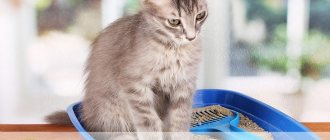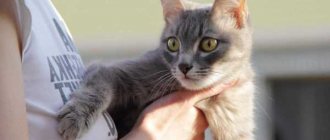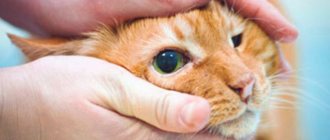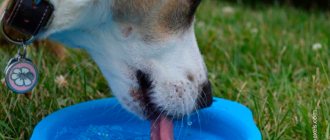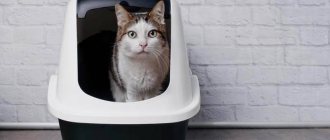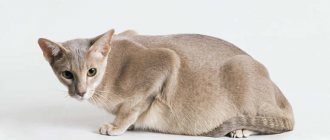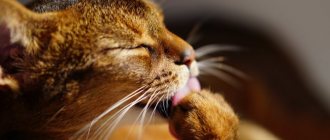26902Pavel
24
If the cat begins to shit anywhere, the pet refuses to go to the toilet in the litter box, and is looking for a secluded place to relieve itself, then it is very important to establish the root cause of this behavior. Cats are naturally very clean creatures, but if you do not instill in your pet useful, correct behavioral skills, the cute creature can cause a lot of problems. Compared to the stench, the specific aroma of kitten urine, and damaged personal belongings, the rest of the furry purr’s antics will seem like cute pranks. Faced with a similar problem, here are some tips that will help you wean your cat from shitting anywhere.
The cat stopped going to the litter box, what should I do?
Urinary incontinence in cats is divided into several types, according to the nature of the manifestations:
- The cat's urine is constantly flowing in small drops. The cause of this disease is a weakening of the muscles that control the sphincter. Another reason is weak bladder muscles that are unable to stretch and contract.
- The inability to tolerate is called urge incontinence. Urine excretion occurs spontaneously as soon as the pet feels the urge. Such animals do not have time to reach the tray, but strive towards it.
- Stress incontinence has nothing to do with psychological stress. This refers to a sharp increase in pressure in the abdominal cavity, which leads to urination. In such animals, discharge can occur, for example, from a sharp jump.
- Reflex discharge occurs when the pet does not feel the urge to pee. Emptying occurs reflexively.
- Nocturnal inability to hold urine, as the name suggests, occurs at night when the pet is sleeping and cannot control the urge to pee.
If there is any suspicion of a disease, the owner should contact a veterinarian.
How to stop a cat from pooping on the bed: proven methods
It is not difficult to train a small kitten to use the litter box. But if an adult cat suddenly changes its habits, or the animal is taken from the street, only those who show patience and love will succeed.
The owner must show the cat that he is against pooping anywhere and take care of cleaning:
- dirty floors are instantly washed and disinfected;
- you can use an odor remover;
- dirty shoes are thoroughly cleaned and put away.
Many cats urinate in one litter box and defecate in another. In this case, the problem can be solved in the simplest way: just place two containers next to each other.
If the cat is left alone for a long time, you will have to buy another potty, because this animal will not go into a dirty container.
Sometimes it is enough to change the brand of stuffing to the one the cat is used to. If there is a need to accustom the cat to a different filling, the change is made gradually, mixing the new brand with the old one in ever increasing proportions.
After making sure that the animal is healthy, you can apply educational measures:
- give a treat every time the cat goes into the litter box: to positively reinforce correct behavior;
- place dishes with food where they are dirty - cats do not go to the toilet where they eat;
- in cases where “not a single bowl is enough,” you can put dry food in places that have been thoroughly washed with urine or feces.
If the cat is accustomed to walking on any object that can be temporarily removed (rug, chair), then it is better to remove it completely or not let the cat into the room. But it cannot be guaranteed that, having stopped pooping in the wrong place for some time, even for a long time, the cat will not use this thing as a toilet again after some time.
For a small kitten, a very effective method is to soak a rag in his urine and place it in the litter box. The smell will guide the animal to the right place. The same can be done with an adult cat brought from the street.
A good way is to place the litter box where the cat starts defecating, gradually moving it to where the owner needs it. Often the cat obeys or does not notice the change in the position of the potty. But sometimes you have to put up with this and constantly move the tray to the corner chosen by the animal.
You can make the location chosen by the cat inaccessible:
- cover it with something that is better unpleasant for the paws;
- cover with a strip of double-sided tape;
- make inaccessible (block, cover).
Sometimes it is effective to create an uncomfortable situation at the moment when the cat is sitting in the corner of his choice (unexpected appearance, applause). But the animal always understands that it is doing bad things and tries to do it when no one is around. The owners will have to look, and perhaps more than once.
To prevent a cat taken from the street from marking the entire floor, you can collect its scent on a porous rag (by rubbing it on wool, for example) and spread its pieces across the floor. Then the animal will understand that this is its territory and that it does not need to be marked.
To prevent pets from spraying gonad secretions and urine in the apartment, males are castrated and females are sterilized. But if this is done too late, when the behavior has already been corrected, the operation will no longer remove the tags. Your veterinarian will help determine the correct age for this procedure.
An animal that shits in the wrong place in order to find a sexual partner can simply be given the opportunity to satisfy its instinct, and silence and cleanliness will return to the apartment.
Causes of urinary incontinence
Neurogenic
Caused by a malfunction of the nervous system, which can occur from injuries, tumors and hernias in the spine or brain. Nerve endings are pinched or ruptured, so their conductivity is disrupted.
Structural anomalies
They can be congenital (hypoplasia, ectopia), acquired (urethral and bladder stones, formation of urethrovaginal fistulas, etc.).
Functional disorders
Occur due to diseases affecting the functions of the excretory system. So, with urinary tract infections, inflammation of the walls of the bladder and urethra occurs, so the contractile activity of the bladder is disrupted, it becomes hyperactive.
With stones, tumors of the bladder, kidneys, adrenal glands, acute urinary retention may occur in a cat. Cystitis and nephritis are also accompanied by urination problems.
Factors such as proper pet maintenance, feeding regimen, and lack of stress are very important. Too fatty or spicy foods make the urine more alkaline, which can lead to itching, burning of the urethra, and inflammation of the upper parts of the urinary system. Therefore, it is strictly forbidden to feed an animal with food from our table.
Features of kittens
A kitten may need to go to the toilet frequently for a variety of reasons. In very young kittens, the problem may be associated with congenital pathologies such as malformations of the bladder, diverticulum of the ureteral orifice, urethral stricture, urethrorectal fistula, atony or hypertonicity of the sphincters. In older kittens, cystitis can be caused by stress. Also, kittens aged 7–8 months have episodes of urolithiasis.
Symptoms
With night incontinence, the pet wakes up “in a puddle”; with urgent incontinence, the pet does not have time to run to the litter box. Reflex voiding is the most noticeable: the animal can urinate anywhere at any time.
The owner needs to analyze the general condition of the animal, for example, lethargy, drowsiness, aggressiveness or irritability. Other behavioral disorders: anxiety, refusal to go to the litter box or, conversely, frequent visits to the toilet, also require attention. Pink urine in a cat, the presence of mucus and impurities in it, is an important “bell” to immediately consult a doctor. Do not try to treat the animal yourself. Only after a complete examination and passing all tests can treatment be prescribed.
What other measures to take
In order to understand how to correct the animal's behavior, it is necessary to establish the reason why it began to use the entire house as a toilet. When this motive is established, it is not necessary to punish the cat who has shit; sometimes you can return him to the litter box using gentler methods.
What to do for skeptics
All people, regardless of whether they believe in omens or not, must remember that it is necessary to accustom a kitten to the litter box from the first days of life. However, teaching a four-legged pet to take care of its natural needs in a specific part of the house is only half the battle. Next, you need to make sure that the litter in the cat's litter box is always fresh and the tray is clean, otherwise the cat may start looking for another litter box.
If everything is in order with the tray, and your four-legged friend has long been accustomed to it, but suddenly begins to mark the owner’s bed or other objects in the home, the following will help to prevent him from doing bad things:
- If the animal is sick (diarrhea or disease of the genitourinary system), it should be shown to a veterinarian, who will prescribe treatment for the cat. As a rule, the recovered pet returns to the tray on its own.
- If a person offends a cat and takes revenge on him for something, it would be good if the owner tried to understand why this happened. Perhaps the cat felt that the owner’s love for her had decreased due to the appearance of a new family member (child) or another animal in the house. In this case, the owner of a four-legged pet should pay more attention to it for some time. You shouldn't punish your cat for having shitty shoes or a blanket on the bed. It will be enough to defiantly ignore him after each incident. And, conversely, after any proper trip to the litter box, pet the cat and treat him with his favorite treat.
- If the purr poops all over the house because he is already old and simply does not have time to reach the litter box, and the owner loves him so much that he does not want to put him to sleep, then the solution may be to install another cat litter box in a different place. An older cat can be easily trained to use this type of litter box by placing anything that smells like her urine in the spare tray.
- The worst option is when a young male cat urinates on the furniture and belongings of the owners, marking his territory. In this case, it is sometimes impossible to return it to the tray in the usual way, even if all the marked places and objects in the house are treated with chemicals that repel strong odors. Castration is the only way to wean an animal from bad behavior.
Examination by a veterinarian
The doctor needs to tell all the symptoms that the owner noticed. During the examination, the veterinarian will perform palpation, which can be used to identify large tumors and organ development abnormalities.
In case of incontinence and other urological disorders, a urine test will be prescribed, most often microscopy of the sediment will be required. Previously, we have already given a detailed explanation of a urine test for a cat. If necessary, ultrasound and x-rays are also performed.
Additional studies may be needed, such as a blood test, microflora culture, and analysis of renal epithelium in the cat’s urine.
Important: obvious neurogenic disorders such as injuries, tumors, spinal hernias, and urinary disorders are treated by eliminating these factors.
In cases of functional disorders, a complete and comprehensive examination cannot be avoided. Only a complete collection of all indicators will make it possible to correctly diagnose and correctly prescribe treatment.
During the examination, the veterinarian will recommend using special diapers for animals. There should always be a clean, absorbent diaper on the sleeping area. These care items are sold at any pet store.
Important: do not scold your pet for its inability to tolerate, do not punish it under any circumstances. A stressful situation will only harm the animal, but affection and care, on the contrary, will help cope with the disease.
Main
- There are many reasons for frequent urination, from cystitis to serious systemic diseases.
- Regardless of age, if a cat pees often and little, this is always a pathology that needs to be understood and treatment selected.
- To make a diagnosis, a comprehensive diagnosis is required. In most cases, this is a urine test, blood tests, and ultrasound of the genitourinary system.
- There is no symptomatic treatment in this situation, since in each specific case it is necessary to look for the cause of the disease and treat it.
We get tested
It is better to take any tests in the morning on an empty stomach. The only exceptions are emergency cases, if the pet suddenly becomes ill and needs emergency hospitalization.
Donating blood is easy: the veterinary nurse will find a vein and take a portion of blood without any problems.
Many owners are concerned about the question of how to collect urine from a cat for analysis. To do this, prepare a tray: remove the filling, wash it, and pour boiling water over it. There is no need to use aggressive detergents such as bleach. Even if the pet doesn’t like the empty tray, sooner or later he will go into it. Drain the liquid into a jar and take it to the clinic.
If your pet does not have time to reach the tray, put a diaper on it. Later, squeeze the diaper into a jar for analysis. But this option is not very good, since the composition of the diaper can change the composition of the urine.
Another option: go to the clinic. To take the test, the doctor will insert a catheter. Catheterization is not very comfortable for the furry patient, but is completely painless. The most accurate and pure material is considered to be obtained by a-puncture of the bladder. The needle is inserted through the abdomen into the bladder, then the required amount of liquid is sucked out. The procedure is easily tolerated by animals; anesthesia or freezing is not required.
Why did the cat start shitting in the room?
The first thing you need to understand is why the cat began to upset its owners:
- This may be due to diseases of the gastrointestinal tract or genitourinary system.
- It is possible that the animal attracts attention in this way, showing that it needs help.
- Sometimes a cat’s toilet begins to be associated with pain. In this case, any attempts to return it to the tray will remain in vain until it is completely cured.
Important! If a cat experiences pain, pain or simply unpleasant sensations, if it cannot restrain involuntary urination, then educational measures are useless. In this case, urgent assistance from a veterinarian is necessary: a timely diagnosis and proper treatment will help solve the problem.
Main reasons not related to health:
- a significant change in the situation (moving, renovation, buying new furniture);
- non-acceptance of the premises where the toilet is installed;
- aversion to the smell of the material from which the tray is made (or its shape);
- antipathy to the filler (or its rare replacement);
- conflict between cats living together;
- lack of attention from the owners.
Sometimes an animal takes revenge for an insult in this way or protests if it doesn’t like something. This is his way of “explaining” to the owners: something is not as the cat wants. But there is no need to look for human logic and conscious behavior in such actions: everything is spontaneous, situational and subordinate to instincts.
Our article – rating of trays for cats – can help you with choosing the right accessory.
The reason can be elementary:
- the toilet was moved (turned);
- another cat went into the litter box;
- there is not enough food in the feeder and not enough water in the drinking bowl;
- The family pet is old, and these are age-related problems.
Sometimes a cat stops going because something startled her during a previous trip to the toilet: for example, someone suddenly walked by while the cat was doing her business.
A separate block is the natural need to mark the territory, protecting it from the encroachments of other animals or even guests who come to the house. And also in an effort to attract sexual partners. This is a powerful animal instinct, which cannot be overcome by educational measures.
Urinary incontinence in cats: treatment
Treatment is prescribed by the doctor after a complete history collection. Based on the results of tests and studies, the veterinarian determines the exact cause of the disease. If the inability to endure is caused by trauma, then all efforts are directed towards treating the trauma. The same applies to hernias and tumors: by getting rid of them, it is most often possible to normalize urination. If spinal cord injuries cannot be completely cured, and the inability to control the desire to pee persists, palliative measures are prescribed: homeopathy, physiotherapy, massage, and the use of special rehabilitation means.
If a cat has bloody urine, what should owners do?
It is necessary to bring your pet to a veterinarian as soon as possible, since blood in the urine is a possible sign of many diseases:
- Infections of the genitourinary system. Treatment is usually medication. A course of antibiotics, immunomodulators, and vitamins will put your pet back on its feet and relieve problems with urination.
- Blood impurities in the analysis occur in the presence of stones in the kidneys and/or bladder. Only by curing urolithiasis (urolithiasis), and, if necessary, operating on the animal, can you get rid of blood impurities and incontinence.
- Structural anomalies are subject to surgery. For example, suturing a vesicovaginal fistula will prevent vaginal exudate from entering the urine, and vice versa. By isolating the bladder from the constant causative agent of inflammation, it will be possible to cope with incontinence.
Prevention of recurrence of incontinence in a pet is by maintaining a proper diet, hygiene and an anti-stress environment at home.
Inappropriate urination in cats
The two main reasons for visits to the veterinarian regarding cat behavior issues are aggression and inappropriate urination; According to most doctors, the second problem is more widespread.
Problems with inappropriate urination can in many cases be successfully treated using medical diagnostic equipment and medications (in a situation where it is a condition of abnormal urination), but when cats begin to urinate in the house, the owner is more likely to consult an ethologist (behavioral specialist) than to a veterinarian.
KEY POINTS
- Inappropriate urination in cats can be multifactorial; it is necessary to search for both physiological and psychological reasons
- A thorough examination of the medical history is necessary to make an accurate diagnosis.
- Owners may be inadvertently exacerbating the problem.
- Treatment can be varied and continuous
Cases of inappropriate urination in cats can be divided into three etiological groups.
1. The first group consists of healthy animals in which urination in inappropriate places is a reaction to any situation.
2. The second group includes those whose urinary problems are the result of physiological disorders.
3. The third group includes animals whose initial problem is urinary tract disease.
However, such a classification draws a line that nature does not always recognize: in reality, these three groups often “overlap.” The actions of owners and their reactions to the cat’s behavior often lead to the emergence of complex multifactorial diseases.
In addition, the speed with which cats acquire new habits complicates the etiological diagnosis of urinary disorders.
INappropriate URINATION IN HEALTHY CATS
During your consultation, your veterinarian will perform a general examination, and you should not be surprised if your cat is found to be in good physical condition. However, owners are rarely reassured by the excellent condition of the animal; They are often more concerned about the condition of their furniture, and the initial goal of contacting a professional is to make sure that the cat will no longer urinate in inappropriate places in their home.
..Territorial marking
Cats mark their territory by leaving trails of pheromones. This is done in three different ways: facial marking, scratching and urination. Although urine marking is not a pathological behavior, owners are unhappy with it and usually seek a “quick fix” for the problem.
Such impatience often leads to the development of the resulting disorder into a physiological disease. By marking their territory with urine, cats leave pheromone marks for strangers; Facial marking, on the other hand, is only necessary for the cat itself and does not serve any function in establishing relationships.
The “effect” of the act of urination, which is noticeable from a distance, is enhanced by a specific pose, which makes it clear to the surrounding cats that the territory is already occupied. Such a pheromone mark counteracts territorial encroachment.
If the marking is effective, the cat will not need to continue marking and the behavior will stop on its own. Urine marking is important for the cat's peace of mind as it keeps away anyone who encroaches on its territory. However, if intrusions continue, the animal will mark more often and in more places. This in itself will become a source of stress for the cat, as competition for territory will increase.
Although a normal behavior in itself, marking becomes pathological when it reaches a certain frequency. As an example, consider the following human situation. It is considered normal to mark the inside cover of a book you intend to lend to someone. Some libraries also label pages within the book. However, if you mark all the pages, it becomes abnormal and unnecessary. When you read a book marked in this way, you will be preoccupied with thoughts that someone might steal it, and you will become paranoid.
Clinically, urine marking is distinguished from simple urination by the animal's posture.
Cats mark by pointing their urine upward. The animal stands upright and releases small volumes of urine. It leaves a mark on the selected vertical surface (of course, clearly visible: a stain with a noticeable odor). This behavior is accompanied by specific actions. The animal scrapes the floor with its paws in front of the vertical surface it is about to mark, gradually turning and approaching the selected area. The animal's back is arched, the body position is straight, the tail is held vertically and trembles.
For practitioners, the challenge is to minimize owner reaction. Both the veterinarian and the cat owner need to remain calm, first of all, in order to correctly determine the cause of the problem and then prevent it from spreading. Owner irritation may also make it difficult to obtain a detailed description of the sequence of events. The main question is whether territorial marking is the problem.
One factor that can assist the practitioner is the presence or absence of burying behavior. Cats that try to bury their urine by scratching at a surface they just soiled are definitely not marking territory. This action is often noticed by owners as annoying and can be useful for diagnosis.
Once the diagnosis of marking (i.e. "reactive" marking by a healthy cat) is confirmed, subsequent treatment is quite simple:
- The veterinarian should point out to the owner the need to remain calm when the animal is marking objects with urine. It may be necessary to reduce the cat's perception of the problem by using an anxiolytic (such as trioxazine).
- The owner should stimulate marking with facial pheromones using sprays, which are quite effective in such cases. Pheromone spray
more difficult to use and if the cat's behavior irritates the owner, this may lead to their incorrect use (for example, irregular use, over-spraying in some places and not enough in others, etc.)
Owners often begin to monitor their cats more closely to prevent further urination or to catch the animal in the act. Eye contact meets a natural reaction inherent in the cat’s natural ethogram: being under such observation, she feels threatened. This threat increases feelings of insecurity and increases the need to spray urine. Veterinary specialists need to explain in detail to the owner that he should not be overly intrusive when watching the animal.
Proper treatment will resolve the problem within a few weeks, unless the condition has become pathological.
..Sexual marking and upbringing mistakes
Sexual marking is similar to territorial marking, but the cat will also release facial pheromones. This specific behavior is determined by sex hormones and can be eliminated by castration of cats. Sexual marking is also observed in cats.
Urination in a place not intended for this purpose as a result of improper upbringing is rare. By the time they get to a new owner, kittens have usually already been taught cleanliness by their mother. Owners may only occasionally detect nighttime urination in inappropriate places in very young kittens. According to the author, such incidents are the result of placing the litter box too far from the cat's bed.
INAPPROPRIATE URINATION ASSOCIATED WITH PHYSIOLOGICAL DISORDERS
Today, there is no doubt that incidents of inappropriate urination by a cat should cause concern for the owner. This simple idea has emerged in the last few years and has replaced the traditional idea that an animal takes “revenge” on its owners in response to “inappropriate” living conditions.
The reality is much more complex and can be caused by several pathological conditions:
• phobias, • anxiety, • depression.
..Phobias
Zana's case is an excellent illustration of this condition. Zana is a cat whose owners came to the author for consultation with their last hope and complaints that she had been urinating inappropriately for the past few years.
Physical examination revealed hematuria and hyperacid urine. Antibiotics were initially prescribed and the number of urinations dropped from 10-15 times a day to a much more manageable one episode of urination on upholstered furniture. The owners were initially satisfied, but soon demanded more: the prescribed antidepressant (clomipramine, 0.4 mg/kg) improved Zana's behavior, but she still refused to use her litter box.
Due to the dissatisfaction of the owners and in order to test a new treatment method, the cat was placed in an animal clinic. In the cage where she was kept, the cat systematically urinated past the tray. We added a second, third and then a fourth tray. As a result, it was noticed that the cat had moved all the trays and twisted around to urinate between the trays, which occupied almost the entire space of the cage.
Then the usual litter for the tray was replaced with newspaper. The cat began to urinate in the tray with the newspaper. She was returned to her owners with instructions to use only newspaper in the tray. Since then, the cat has become clean, despite a short-term infection. The newspaper was soon replaced by river sand, then pine bark, and then other materials. It was eventually determined that Zana had a phobia of filler.
There are many other phobias that veterinary practitioners should consider when a cat exhibits inappropriate urination.
The most difficult problem to overcome is social phobia. “Semi-feral” cats that are taken from the street and suddenly placed in an apartment often have phobias (fear of people, noise, other predators), leading to urination in places not intended for this purpose. Such animals are often very excitable, their behavior is an excellent illustration for this article.
In such cases, complex treatment is required. However, the following seemingly simple situations can cause phobias:
- a dog that constantly bothers the cat when it tries to use the litter box;
- a tray located behind a door that hits it every time it opens:
- children who knock on the lid of a closed litter box while the cat is using it.
..Anxiety and inappropriate urination
In nosography, anxiety is defined as a pathological condition that arises either as a result of phobias or as an independent phenomenon.
It is in many ways similar to phobias, when an animal cannot avoid a state of fear because it is formed by the environment or due to internal reasons.
Anxiety can have various clinical manifestations. Very often, cats exhibit aggression, organ dysfunction (digestive, genitourinary, skin) and displaced activity (for example, self-induced alopecia). Such anxiety is often complicated by inappropriate urination.
There are three reasons for these symptoms.
- Discharging natural needs in places not designated for this purpose leads to territorial and emotional disorganization, which provokes anxiety.
- Anxiety leads to the fact that the cat becomes incapable of structuring and properly organizing its territory.
- Anxiety is often accompanied by urinary disorders and, above all, idiopathic cystitis.
Molko is a perfect illustration of this problem. Molko is a two-year-old cat who once lived a happy life. However, his owners divorced and moved away; Molko had to leave the sunny bungalow and move to an apartment on the fifth floor. The divorced husband, who took the cat in, could not cope with the cat's problem of urinating in the wrong places and returned the pet to his ex-wife. Thus, Molko moved to another apartment with children and a dog.
Molko got used to his new surroundings, but he was often caught marking with urine. Then a new man appeared in the family and began to punish the cat. The situation became catastrophic.
At this stage, the owners sought advice from a specialist. The cat at that time was obese and unfriendly, urinating at least five times a day: the urine was foul-smelling and hemorrhagic. In addition, the cat stopped using the litter box and defecated most of his needs into the drain pipe of the technical bathroom, where he was kept locked up. He began to hiss at the slightest provocation and showed characteristic symptoms of feline hyperesthesia.
The following diagnoses were made:
• Cystitis. Molko did not have crystalluria, but the acidity was increased. Cultures (samples collected by cystocentesis and routine laboratory urine analysis) were negative. Cytological analysis showed numerous red and white blood cells but no yeast or bacteria.
• Anxiety. Hyperesthesia syndrome is a common symptom of this condition. Phenomena such as changes in character, diet disruption (Molko ate excessively) and cessation of self-care, which were also closely related to anxiety, were also noted.
• Uncomfortable living conditions. Molko’s living space was limited; no one had caressed him for a long time. He was stressed by the presence of a dog he didn't like.
The prescribed treatment addressed all of the problems listed.
• Correction of cystitis with nonsteroidal anti-inflammatory drugs (NSAIDs) and antibiotics, if necessary until the hematuria subsides, then the use of NSAIDs and possibly glycosaminoglycans.
• Treat anxiety with antidepressants, if necessary, for several months or several years. The author recommends the drugs in the dosage indicated in the Table.
| Choice of drug |
| Phobias, anxiety and depression can be treated with antidepressants. Anxiolytics should be prescribed in addition to these medications or separately in animals at an early stage of disorders (in the reaction phase) |
| Clomipramine is used in low doses (0.3-0.4 mg/kg/day). At this dosage, the effect of beta-adrenergic drugs is weak. Anxiety decreases noticeably by the third week |
| Selegiline is used in double the dose prescribed for dogs, i.e. 1 mg/kg. The sedative effect is significant and occurs after approximately one month of treatment. There are no side effects, but there may be difficulties with oral administration of the drug |
| Fluoxetine is used in an amount of 3 mg/kg (an increased dose is prescribed to treat hyperactivity). The effect on anxiety is good and can be noticeable by the third week of treatment. Water-soluble tablets are preferable: the drug solution can be stored for 24 hours |
| Alpha-casozepine is a good anxiolytic agent. A daily dose of 15 mg/kg is the therapeutic minimum. This is a slow-acting drug. It is mainly indicated in the early stages of stress and social phobias |
| Trioxacin is a sedative with more or less similar indications to alpha-casozepine. It is not powerful enough to correct pathological conditions, but has a beneficial effect at the initial stage of disorders (in the reaction phase) |
| Nonsteroidal anti-inflammatory drugs are not anti-inflammatory drugs. however, their use often provides the comfortable conditions necessary to correct the pathological condition. They are recommended for the treatment of idiopathic cystitis |
The practitioner must be sure that the use of the medication in this manner will not cause urethral blockage, which is a potentially serious complication after the use of some antidepressants (for example, clomipramine).
• Expanding the territory and ending punishment in any form. In Molko's case, this implied that he should have been allowed out of the technical bathroom periodically after the first weeks of treatment. Active use of a pheromone diffuser and an attempt to restore the emotional connection between the animal and the owners were also recommended.
..Depression and inappropriate urination
Cats spend a lot of time sleeping. This can sometimes make it very difficult to differentiate between a healthy cat and a depressed cat. Is your cat really sleeping a lot because he's depressed, or is he just lazy?
A depressed cat, however, often has an impaired ability to organize its living space, which leads to urination in inappropriate places.
Older cats often develop a form of depression that involves inappropriate urination, known as involutive depression. In this form of the disease, a depressive state is accompanied by cognitive disorders. A sick cat loses motivation, suffers from acute distress, and loses previously acquired behavior patterns.
Territorial marking becomes erratic as the cat feels insecure and loses control of the territory. If a cat is so unlucky that it loses the goodwill of its owners due to urinating in inappropriate places, the depressive state quickly worsens.
Treatment includes the use of antidepressants, initially accompanied by anxiolytics. Drug treatment should be supplemented by restoration of emotional connections, expansion of living space and careful veterinary supervision. It is not unusual for this condition to occur in aging animals due to other conditions such as arthritis, hormonal imbalances, hypertension, etc. - so veterinary care is often key to restoring the emotional bond between owner and cat
INAPPROPRIATE URINATION AND IDIOPATHIC CYSTITIS
Most cats that require a veterinary ethologist for inappropriate urination have cystitis. By mentioning this, we in no way pretend to reveal to our colleagues some unknown fact, but we think it is important to emphasize that in cats it is often difficult to draw the line between behavioral and physiological disorders and that they often occur simultaneously.
Further work of the veterinarian is complicated by the fact that idiopathic cystitis is a disease of the bladder, one of the causes of which, if not the only one, is stress and anxiety. Treatment must be selected individually in each case, and ideal regimens, unfortunately, do not exist at the moment.
Idiopathic cystitis is clinically indistinguishable from infectious cystitis. Sick cats begin to urinate in inappropriate places. This manifests itself in an increase in the number of acts of urination and an almost complete refusal to use the tray; Instead, the cat finds soft or odorous materials. In the early stages, cats are often caught urinating in the sink or bathtub, but then they often begin to turn their attention to mattresses, sofas, blankets and even pillows. Cats are often disrespectful of property, and owners are sometimes convinced that the cat simply wants to do something “to spite” them.
Because the triggers for idiopathic cystitis are often stressful, some animals will respond by urinating past the litter box one or two times when a “stressful event” occurs, and in such cases the owner will quickly make the connection. However, the owner is often convinced that the cat is purposefully annoying him, so most people who contact him have to explain the problem and point out the relationship of events.
Idiopathic cystitis occurs under the same circumstances as urinary tract infections. Often short and short-lived cystitis develops into classic cystitis. This outcome is hardly surprising; however, we are more concerned about the situation when infectious cystitis develops into simple episodic cystitis, since it can be very difficult to predict such a turn of events and, accordingly, warn the owner.
Our current treatment for idiopathic cystitis includes:
- non-steroidal anti-infective agent;
- anxiolytic or tricyclic antidepressant (urine should be checked for crystalluria);
- an antibiotic at the beginning of treatment to combat secondary infection (the need for this is disputed);
- adding glycosaminoglycans in powder form to food - two 15-day courses per year (the effectiveness of this treatment is disputed);
- It is equally important to expand the cat’s living space, as well as, if necessary, to feed it ad libitum, but with difficult access to food.
For inappropriate urination, ultrasound and x-ray examinations can be performed. Before starting long-term and complex treatment, it is advisable to exclude bladder tumors. When diagnosing cystitis, imaging methods are usually used to examine the walls of the bladder. Cytological examination of urine should be carried out regularly.
It is important that your veterinarian obtain a suitable urine sample from each cat whose owner comes to the clinic because of inappropriate urination. The author's preference is for cystocentesis.
Cystonentesis is a simple, painless procedure that can be performed on most cats without the use of sedation. The bladder should be full or at least palpable. Urine collected this way is sterile. Contrary to popular belief, the presence of traces of blood in such samples is always diagnostically significant. When using a fine (23G) needle, there should be no blood in the urine sample collected by cystocentesis.
CONCLUSION
Helping with inappropriate urination in cats often requires the veterinarian to bring all of his or her knowledge to bear. Referral of the patient to a specialized ethological center is rarely required, but for successful treatment it is necessary to show miracles of patience. The therapy methods are simple, but it can be very difficult to get the owner to carefully follow the doctor’s recommendations. In such cases, the latter’s communication skills become fundamental.
In conclusion, I would like to remind you once again that in cats, psychological and somatic disorders are closely related to each other, especially when it comes to urinating in inappropriate places. To achieve a positive result, the clinician must use an integrated approach. Incidents of inappropriate urination that are purely a behavioral problem are the exception rather than the norm.
Gerard Muller Veterinary Clinic Lille, France (Veterinary Focus 2010-01)
Why does a cat mark territory?
The smell of cat urine is not pleasant, but the smell left after the marks is almost unbearable! The fact is that after the decomposition of the urine of an uncastrated cat, thiols appear, which greatly enhance the smell, although, what’s more... they intensify the stench. Why do well-mannered cats begin to mark their territory? Because you can't go against your instincts. When getting a boy kitten, come to terms with the fact that when he becomes an adult cat, he will absolutely mark the apartment! Therefore - either surgery or?
But first, why does a cat start marking?
- Adjust the crown - the cat considers you an alpha male and strives to take your place in charge
- A cat may consider himself the leader of the pack and use marks to warn others that they are by default of lower rank than him.
It is important to honestly and clearly answer yourself - who you are in this pride and then together we will develop a behavior strategy.
